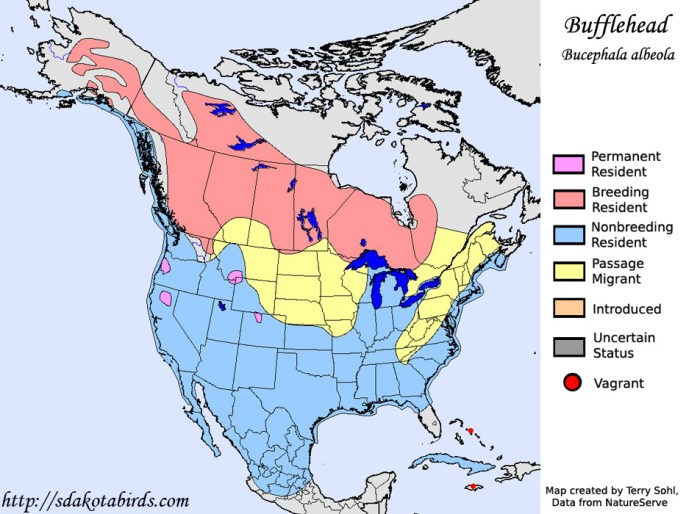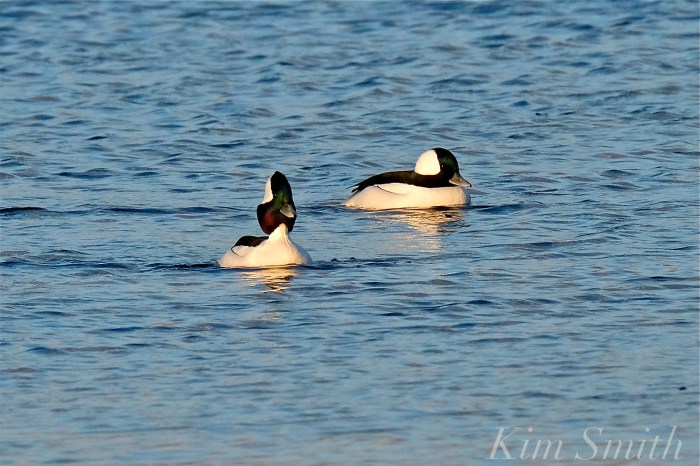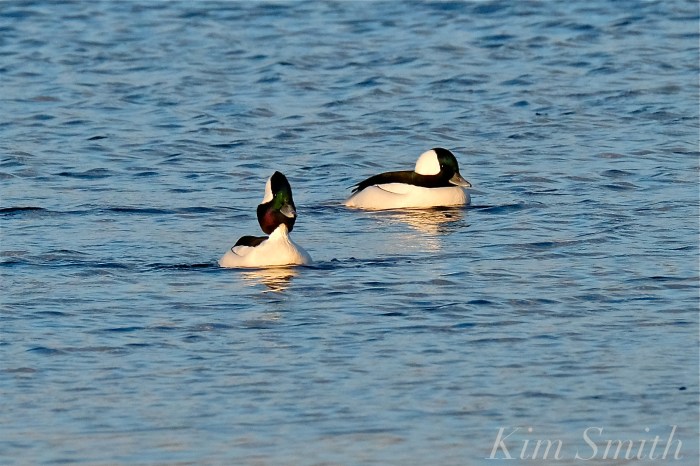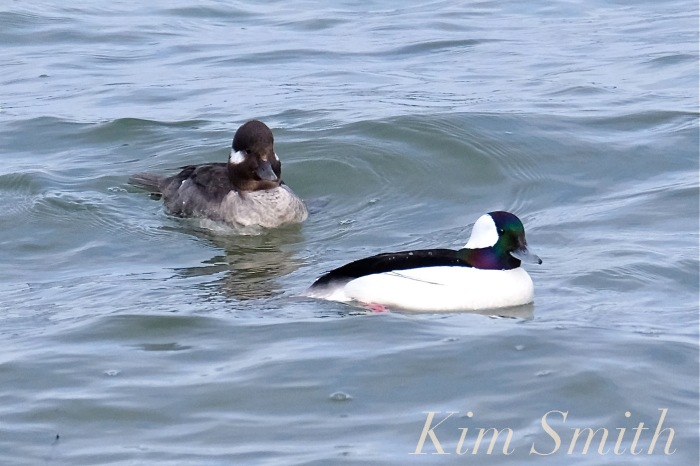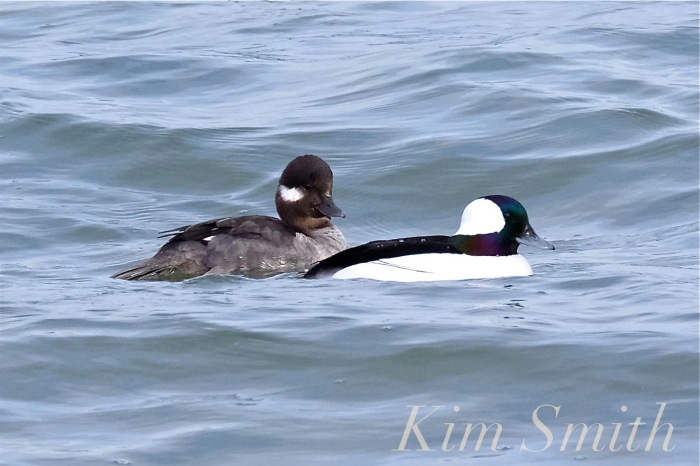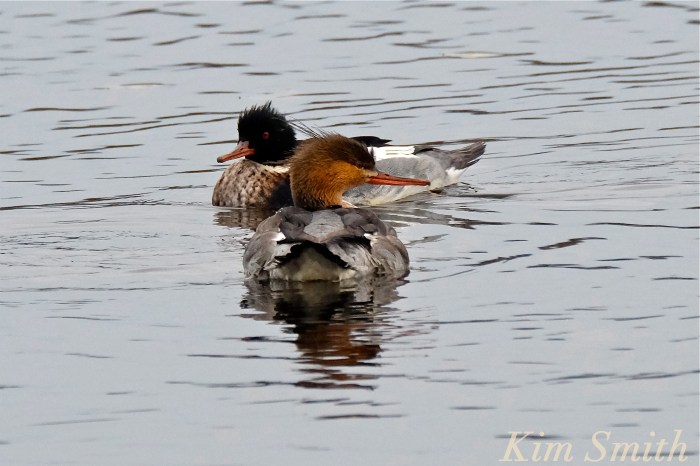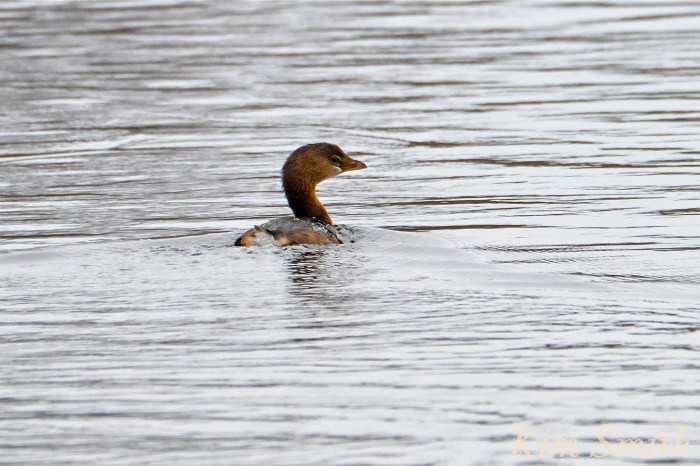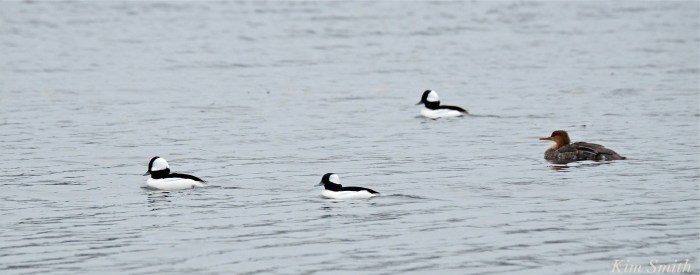The beautiful collection of ducks currently migrating along our shores could also be called ‘A Study in Black and White,’ with a touch of orange, too.
 Common Goldeneye
Common Goldeneye
Swimming inshore with the diminutive, albeit more ubiquitous, Buffleheads are Common Goldeneyes. Both sea ducks are members of the Bucephala genus; their name is derived from the ancient Greek word boukephalos, which means bullheaded and is in reference to their bulbously-shaped heads. During courtship rituals, male members of the Bucephala genus puff out their head feathers, making them appear even more buffalo-headed.
How can you tell the two apart when side by side? Goldeneyes are larger than Buffleheads and they have a circular white patch on their cheek, behind the bill.
Female (left) and Male Buffleheads
 The name Oldsquaw was once used to describe the Long-tailed Duck but has fallen out favor in deference to Native American tribes.
The name Oldsquaw was once used to describe the Long-tailed Duck but has fallen out favor in deference to Native American tribes.
The Cornell Lab of Ornithology has re-vamped their website. From here you can read more about Long-tailed Ducks, but I thought the following was particularly interesting while learning how to distinguish the different plumages. “Unlike most ducks, which molt twice per year, the Long-tailed Duck has three distinct plumages each year, achieved in a complex series of overlapping partial molts. The Definitive Basic Plumage is never worn in its entirety, as portions of Alternate are retained through the summer and elements of the Supplemental are acquired before all of Basic Plumage is obtained. Therefore change in plumage seems continuous from April to October. Unlike other waterfowl, the Long-tailed Duck wears its “breeding” or Alternate Plumage only in the winter. It gets its “nonbreeding” or Basic Plumage in the spring and wears it for the breeding season. Most other ducks wear the nonbreeding plumage only for a short period in the late summer.”
Male and Female Long-tailed Ducks in nonbreeding plumage.
 Male and Female Surf Scoters
Male and Female Surf Scoters
The male Surf Scoter’s well-defined stark white patches against ebony feathers lends this sea duck its common name, “Skunk-headed Coot.” But it is the scoter’s bulbous-at-the-base orange, black and white patterned bill that I find interesting and almost comical. The female is a plainer dull blackish-brownish with light colored patches, one behind each eye and at the base of the bill.
 The number of, and locations of, Brant Geese appear to be increasing as they are readying for the long migration to the Arctic breeding grounds. Brants migrate the greatest distance of any North American goose.
The number of, and locations of, Brant Geese appear to be increasing as they are readying for the long migration to the Arctic breeding grounds. Brants migrate the greatest distance of any North American goose. Brant breakfast.
Brant breakfast.
A lone Canada Goose joined the scene for a moment, but his presence was not welcome by the Brants. His appearance provided a terrific opportunity though to compare the size difference between the Brant and the Canada Goose. You can see in the photo below, the Brant is quite a bit smaller, but that didn’t prevent one from chasing away the Canada Goose.
 Canada Goose in the background, Brant Goose in the foreground.
Canada Goose in the background, Brant Goose in the foreground.
 Bye bye Canada Goose
Bye bye Canada Goose
 Male and Female Common Goldeneyes and Harbor Seals
Male and Female Common Goldeneyes and Harbor Seals
Spread The GMG Love By Sharing With These Buttons:
 Ponds and waterways are filling up with one of the smallest ducks found on our shores, the Buffleheads. A most striking of winter residents (and feisty, too), the male is sharply feathered in black and white, with iridescent purple and green head feathers. The Buffleheads will be here through the winter, with most departing in early spring.
Ponds and waterways are filling up with one of the smallest ducks found on our shores, the Buffleheads. A most striking of winter residents (and feisty, too), the male is sharply feathered in black and white, with iridescent purple and green head feathers. The Buffleheads will be here through the winter, with most departing in early spring. The male’s head feathers are shaded with a beautiful rainbow sheen, while the female is a much plainer sort.
The male’s head feathers are shaded with a beautiful rainbow sheen, while the female is a much plainer sort. 